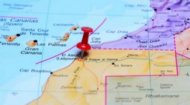|
This colonial period left an indelible architectural mark, evident in the sprawling Plaza de España (now known as Plaza des Nations Unies) and the grand Catholic Cathedral of St. Francis of Assisi, which today stands as a cultural centre. The mid-20th century saw the rise of Sahrawi nationalism, and El Aaiún became a central stage for the growing tensions that would eventually lead to conflict. In November 1975 King Hassan II of Morocco organised what was known as 'the Green March', a large-scale civil demonstration of over 350,000 unarmed Moroccan civilians who marched into the Spanish Sahara (Western Sahara). This was to assert Morocco's claim to the territory as direct response to the International Court of Justice (ICJ)'s advisory opinion on the Western Sahara question which had ruled that the local Saharawi population had a right to self determination. This took place at a time when colonial Spain was sidetracked by its own domestic issues. This led to the Madrid Accords, which were signed on November 14, 1975, between Spain, Morocco, and Mauritania establishing a temporary tripartite administration in the territory of Western Sahara and the beginning of Spain's withdrawal from the region with Spain's administrative responsibilities being transferred to Morocco and Mauritania, partitioning the territory between them. This treaty was widely criticised for disregarding the Sahrawi people's right to self-determination and for being signed just before the death of Spanish dictator Francisco Franco. The signing of these Accords triggered an armed conflict with the Polisario Front, which proclaimed the Sahrawi Arab Democratic Republic (SADR). A UN-brokered ceasefire was agreed upon in 1991, but the status of the territory, including El Aaiún, remains unresolved although Morocco administers the city de facto with a physical presence of Moroccan infrastructure and administration, although, according to the Polisario Front as an occupying force as they continue to consider it the de jure capital of the Sahrawi Arab Democratic Republic. |
El Aaiún Profile |
El Aaiún Profile |
El Aaiún Profile | El Aaiún Profile |
 |

|
El Aaiún is the largest city in the Western Sahara, with a population estimated to be over 200,000. Its social fabric is a tapestry woven from diverse threads with its population including Sahrawis from local tribes, alongside a significant number of settlers from northern Morocco who have moved south over the decades, attracted by economic incentives. This blend creates a unique cultural fusion where Hassaniya Arabic is the primary dialect, but Moroccan Darija and French are also widely spoken.
Fishing is another critical pillar of the economy. The Atlantic coast off Western Sahara is rich with marine life, supporting a thriving fishing industry that provides jobs and export revenue. Furthermore, trade and commerce are bustling, with markets offering everything from traditional crafts to modern imported goods. The Moroccan government has heavily invested in infrastructure, building housing complexes, hospitals, and universities in an effort to secure stability and promote development. For residents, daily life in El Aaiún is a blend of routine and unique Saharan charm. The city is meticulously planned with wide, clean streets, green spaces, and modern amenities, which can feel surprisingly orderly compared to the chaotic energy of northern Moroccan cities. The pace is generally slower and dictated by the heat of the day. For visitors, El Aaiún offers a handful of distinct attractions that speak to its identity: Despite its modern appearance and economic activity, El Aaiún is not without its profound challenges. The overarching political question of the territory’s status creates an atmosphere of underlying tension with this unresolved conflict impacting international investment and development. Socially, the city grapples with the integration of its diverse population and the preservation of its unique Sahrawi cultural identity amidst rapid modernisation and influence from the north while fundamental human rights are frequently monitored by international organisations.
|





 El Aaiún's economic profile is largely defined by two factors: its administrative status and its natural resources. As the regional capital, a substantial portion of the economy is driven by government administration and public services. However, the most significant economic engine is still the phosphate industry. The massive Bou Craa mine (left), located southeast of the city, is one of the largest phosphate reserves in the world. A visible, iconic conveyor belt, stretching over 60 miles to the coast, carries phosphate to the port of Laâyoune El Marsa for export, underpinning the city’s financial existence.
El Aaiún's economic profile is largely defined by two factors: its administrative status and its natural resources. As the regional capital, a substantial portion of the economy is driven by government administration and public services. However, the most significant economic engine is still the phosphate industry. The massive Bou Craa mine (left), located southeast of the city, is one of the largest phosphate reserves in the world. A visible, iconic conveyor belt, stretching over 60 miles to the coast, carries phosphate to the port of Laâyoune El Marsa for export, underpinning the city’s financial existence.



